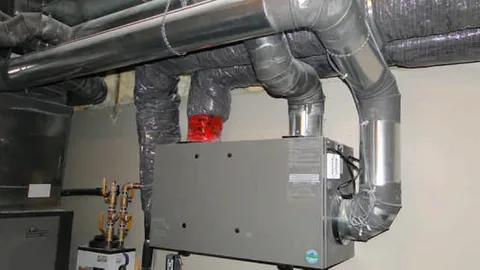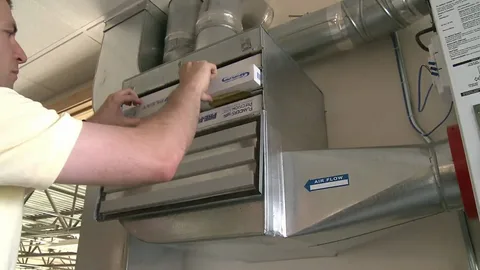Are you looking to improve the air quality in your home or office whilst also saving on energy costs? If so, then opting for an HRV Heat-Recovery Ventilator might be the perfect solution for you. This innovative system not only helps in maintaining a comfortable indoor environment but also offers a range of other benefits that make it a worthwhile investment. In this blog post, we will delve into the various reasons why you should consider using an HRV Heat Recovery Ventilator and how it can positively impact your living or working space.
Understanding the Basics of an HRV Heat-Recovery Ventilator
An HRV Heat-Recovery Ventilator operates on a simple yet highly effective principle: it exchanges stale, potentially polluted indoor air with fresh, filtered air from outside, whilst efficiently conserving the energy used to heat or cool the building. At the heart of this process lies a heat exchanger, where the energy from the outgoing indoor air heats or cools the incoming outdoor air, depending on the season.
This ingenious mechanism ensures that the indoor climate remains stable without the excessive use of heating or cooling systems, thereby promoting a balance of temperature and humidity that contributes significantly to a building’s energy efficiency. The operation of an HRV system is a testament to the advances in building technology, aimed at providing comfortable living and working environments in an ecologically responsible manner. Through its function, an HRV Heat-Recovery Ventilator illustrates the synergy between modern living needs and environmental stewardship, making it an essential component in contemporary building design and management.
The Environmental Benefits of Using the Best Heat Recovery Ventilator
Choosing the best Heat Recovery Ventilator presents a significant stride towards eco-friendly living and working conditions. These systems stand at the forefront of reducing the carbon footprint associated with heating and cooling buildings.
By optimising energy use, they diminish the reliance on fossil fuels, a key contributor to greenhouse gas emissions. Consequently, this transition towards more sustainable energy sources aids in combating climate change.
Improved Air Quality and Its Impact on Health
Enhancing the quality of the air within indoor spaces is a pivotal function of an HRV Heat-Recovery Ventilator, contributing significantly to the health and comfort of inhabitants. The constant influx of fresh, filtered air, accompanied by the expulsion of stale, contaminated air, ensures a reduction in pollutants such as dust, allergens, and harmful chemicals that are often present in closed environments. This filtration process is instrumental in mitigating health risks associated with poor air quality, including respiratory conditions, allergic reactions, and long-term effects on wellbeing.
Furthermore, by maintaining optimal levels of humidity, HRV systems prevent the proliferation of mould and dampness, conditions that can lead to serious health problems and structural damage over time. This aspect of HRV technology is particularly beneficial for individuals suffering from asthma or other respiratory issues, as it promotes a cleaner, healthier air environment conducive to improved lung health.
Moreover, the introduction of fresh air into living and working spaces can enhance cognitive function, concentration, and overall mood, underscoring the intrinsic link between air quality and mental health. The HRV Heat-Recovery Ventilator emerges as a cornerstone in establishing a healthy indoor atmosphere, highlighting its indispensable role in safeguarding both physical and mental health through superior air quality management.
Cost-Effectiveness and Energy Savings of Heat Recovery Ventilator
The initial outlay for a Heat Recovery Ventilator may appear substantial, yet it’s an investment that promises tangible returns in the long run. These systems are engineered to minimise the necessity for conventional heating and cooling, thereby facilitating notable energy savings. Over time, the reduction in energy consumption can lead to substantial financial savings, making the HRV system a cost-efficient choice for property owners. The conservation of energy not only reflects on lower utility bills but also contributes to the extended durability of HVAC equipment.
By easing the demand on heating and cooling units, the wear and tear on these systems are significantly reduced, which in turn delays the need for replacements or extensive repairs. This aspect of HRV technology enhances its appeal as a sustainable and economically viable option for modern buildings.
Furthermore, the improved energy efficiency attributable to HRV systems can enhance the building’s value by aligning with contemporary standards for sustainability and energy conservation. In essence, the adoption of an HRV Heat-Recovery Ventilator represents a prudent financial strategy that aligns with environmental stewardship and long-term cost savings, cementing its position as a valuable addition to any energy-conscious household or business.
Ease of Integration with Existing Systems
An HRV Heat-Recovery Ventilator is remarkably versatile, offering straightforward compatibility with a broad spectrum of heating, cooling, and ventilation systems already in place within buildings. This adaptability ensures that property owners seeking to enhance their indoor air quality and energy efficiency can do so without the hassle of embarking on extensive or intrusive structural changes. The design of HRV systems facilitates their incorporation into both new builds and existing structures, making them a practical choice for upgrading the performance of a building’s climate control measures. Whether it’s a residential property or a commercial space, the installation process is designed to be as non-disruptive as possible.
Adaptable Nature of HRV Systems
The innate flexibility of HRV systems allows them to adapt effortlessly with varying infrastructure settings, an attribute that sets them apart in the domain of air quality improvement. Be it an age-old structure or a modern architectural design, the versatility of HRV is unmatched.
Economic Benefits
Furthermore, adopting an HRV system for your building doesn’t require heavy financial investment, making it an economically viable choice. Despite offering advanced climate control solutions, the cost of installing an HRV is relatively affordable and, in the long run, may contribute to significant energy savings.
Non-Intrusive Installation
Most importantly, integrating an HRV system into your existing climate control setup is a fuss-free affair. Trained professionals ensure a swift, clean installation with minimal intrusion, ensuring daily activities are not disrupted, making the process seamless and efficient.
Maintenance and Longevity of Energy Recovery Ventilator
Maintaining an energy Recovery Ventilator involves simple yet essential practices that are crucial for preserving the system’s efficiency and extending its service life. Regular maintenance, predominantly the replacement of filters and periodic checks of the system, ensures that it operates at peak performance. The filters play a pivotal role in trapping pollutants and preventing them from entering the indoor air stream; hence, they should be inspected and changed approximately every six to twelve months, depending on the environment and level of use.
Apart from filter replacement, it is advisable to schedule an annual inspection with a qualified technician. This check-up includes examining the heat exchanger, verifying the integrity of seals, and ensuring that all components are functioning correctly. Such proactive maintenance not only safeguards the system against premature wear but also identifies potential issues before they escalate into costly repairs.
It’s also worth noting that the ventilation ducts themselves should not be overlooked. Ensuring that these are clear of obstructions and debris will facilitate optimal airflow, further enhancing the HRV system’s efficiency and contributing to its longevity. By adhering to these maintenance guidelines, homeowners and property managers can enjoy the full spectrum of benefits offered by an HRV Heat-Recovery Ventilator, including sustained energy savings and improved indoor air quality, for years to come.
The Role of HRV Systems in Modern Building Regulations
In the contemporary landscape of building design and construction, HRV Heat-Recovery Ventilators have emerged as pivotal components in meeting and exceeding the stringent demands of modern building regulations and sustainability standards. As governmental bodies and regulatory agencies intensify their focus on reducing energy consumption and minimising environmental impact, the integration of HRV systems into new buildings has transitioned from an optional enhancement to a mandated requirement in many jurisdictions.
Efficiency and Conservation
The essence of HRV systems lies in their capacity to reclaim otherwise lost energy, utilising it to preheat incoming fresh air. The technology is especially advantageous during colder months when heating systems tend to consume copious amounts of energy.
Indoor Air Quality and Comfort
Equally noteworthy is the contribution of HRV systems to the improvement of indoor air quality and occupant comfort. They adeptly balance indoor humidity levels and continuously replenish indoor environments with filtered, fresh outdoor air, reducing indoor air pollutants and enhancing overall living conditions.
Cost Savings and Economic Advantages
Ultimately, these benefits culminate into significant energy cost savings. Homeowners and building operators can enjoy substantial reductions in energy bills, providing a strong economic incentive for the incorporation of HRV systems. Furthermore, the system’s efficiency can increase property value, contributing to long-term financial benefits.
Boosting Efficiency with the Best Energy Recovery Ventilator
Selecting the best energy Recovery Ventilator tailored to your unique requirements is instrumental in elevating both the efficacy and functionality of the system within your premises. Critical considerations that should guide your choice include the overall dimensions of the space, prevailing local weather patterns, and specific demands for air purity. An HRV system that is perfectly matched to the scale and environmental conditions of your property ensures that you not only maximise the recuperation of warmth from exhausted air but also significantly enhance indoor air quality without compromising on energy consumption.
Moreover, it is essential to evaluate the features and specifications of various HRV models to determine their compatibility with your existing HVAC setup. Advanced units come equipped with sophisticated filters and sensors that fine-tune the ventilation process, adapting in real time to changes in indoor air quality and external climatic conditions. This adaptability is crucial for maintaining an optimal balance of fresh air influx, humidity control, and thermal comfort throughout the year.
Consulting with professionals who specialise in ventilation solutions can provide invaluable insights, helping you navigate the plethora of options available on the market. Their expertise can assist in identifying an HRV Heat-Recovery Ventilator that not only meets your current needs but is also scalable to accommodate future requirements as your space evolves. Investing in the right HRV system is a strategic step towards achieving unparalleled energy efficiency, underscored by the promise of a healthier, more comfortable indoor environment for occupants.
Conclusion
Embracing an HRV Heat Recovery Ventilator represents a forward-thinking approach to managing indoor environments. It not only signifies a commitment to enhancing living and working conditions through superior air quality but also aligns with the urgent need for sustainable energy practices. The diverse benefits, ranging from health improvements to economic gains, underscore the system’s role as an indispensable part of modern building management. The versatility in application across various types of buildings further demonstrates its universal appeal and adaptability.
FAQs
Many questions arise when considering the installation of an HRV Heat-Recovery Ventilator. Here are answers to some frequently asked questions:
Q: How often should the filters in an HRV system be changed?
A: Filters should ideally be inspected and possibly changed every six to twelve months, depending on usage and environmental factors.
Q: Can an HRV system be installed in older buildings?
A: Yes, HRV systems are designed to be versatile, allowing for installation in both new and existing buildings, including older structures.
Q: Does an HRV system replace the need for traditional heating and cooling systems?
A: Whilst an HRV system significantly enhances energy efficiency and can reduce the reliance on traditional systems, it is designed to work in conjunction with existing heating and cooling units to maintain optimal indoor temperatures.
| Related Business Listings |
| Contact Directory |
| Local Business Profiles |



